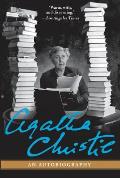More on Christie and Wodehouse
After posting about the possible influence of P. G. Wodehouse on Agatha Christie, I got a hold of Christie’s autobiography to see if it had any information to refute or confirm that hypothesis.
(I also looked at Laura Thompson’s biography, Agatha Christie: A Mysterious Life, but nothing in it contradicted Christie’s own statements.)
As a young writer, Christie tried to place her literary short stories: “I sent them to magazines, but expected them to come back, and come back the usually did.” However, her autobiography didn’t name those magazines, so I can’t say whether any were publishing Wodehouse in the mid-1910s.
Christie definitely had Dr. Watson in mind when she created Capt. Hastings for her first detective story, The Mysterious Affair at Styles, and she definitely didn’t think much of the character:
As for her writing process, Christie’s autobiography confirmed that she “finished the last half of the book, or as near as not, during my fortnight’s holiday. Of course that was not the end. I then had to rewrite a great part of it—mostly the over-complicated middle.” Again, it’s not clear when she developed Hastings and his rapport with Poirot, which is where I see the resemblance to Wodehouse’s Bertie and Jeeves.
Christie started sending her rewritten manuscript to publishers during the World War. It stayed at The Bodley Head through the Armistice and for “nearly two years” before the publisher asked for revisions. Christie described those changes merely as the “last chapter” and “a few more alterations,” suggesting that by that point the main characterizations were intact.
Thus, it appears that Christie most likely developed Poirot and Hastings’s interactions during her 1917 revisions, after stories exploring the Jeeves and Bertie relationship had started to appear in British magazines. But the autobiography offers no additional evidence of possible influence from Wodehouse.
Christie did refer to her first husband’s wartime “soldier servant and batman” as “a kind of Jeeves—a perfection.” But of course she could have read Wodehouse’s stories anytime in the decades between her debut and when she wrote her memoirs.
(I also looked at Laura Thompson’s biography, Agatha Christie: A Mysterious Life, but nothing in it contradicted Christie’s own statements.)
As a young writer, Christie tried to place her literary short stories: “I sent them to magazines, but expected them to come back, and come back the usually did.” However, her autobiography didn’t name those magazines, so I can’t say whether any were publishing Wodehouse in the mid-1910s.
Christie definitely had Dr. Watson in mind when she created Capt. Hastings for her first detective story, The Mysterious Affair at Styles, and she definitely didn’t think much of the character:
At that date I was well steeped in the Sherlock Holmes tradition. So I considered detectives. Not like Sherlock Holmes, of course: I must invent one of my own, and he would also have a friend as a kind of butt or stooge—that would not be too difficult.That certainly doesn’t sound like she put a lot of thought into Hastings when she planned that story. “He was a stereotyped creation,” she wrote, though she “quite enjoyed” him.
As for her writing process, Christie’s autobiography confirmed that she “finished the last half of the book, or as near as not, during my fortnight’s holiday. Of course that was not the end. I then had to rewrite a great part of it—mostly the over-complicated middle.” Again, it’s not clear when she developed Hastings and his rapport with Poirot, which is where I see the resemblance to Wodehouse’s Bertie and Jeeves.
Christie started sending her rewritten manuscript to publishers during the World War. It stayed at The Bodley Head through the Armistice and for “nearly two years” before the publisher asked for revisions. Christie described those changes merely as the “last chapter” and “a few more alterations,” suggesting that by that point the main characterizations were intact.
Thus, it appears that Christie most likely developed Poirot and Hastings’s interactions during her 1917 revisions, after stories exploring the Jeeves and Bertie relationship had started to appear in British magazines. But the autobiography offers no additional evidence of possible influence from Wodehouse.
Christie did refer to her first husband’s wartime “soldier servant and batman” as “a kind of Jeeves—a perfection.” But of course she could have read Wodehouse’s stories anytime in the decades between her debut and when she wrote her memoirs.



No comments:
Post a Comment